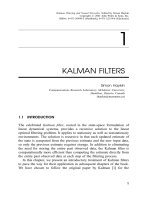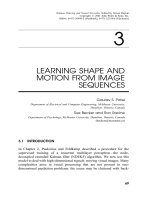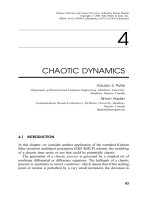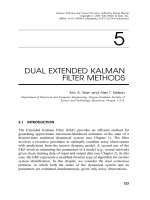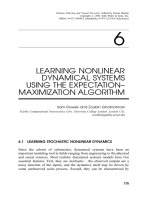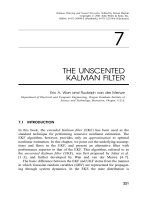Tài liệu Kalman Filtering and Neural Networks P3 doc
Bạn đang xem bản rút gọn của tài liệu. Xem và tải ngay bản đầy đủ của tài liệu tại đây (712.02 KB, 13 trang )
3
LEARNING SHAPE AND
MOTION FROM IMAGE
SEQUENCES
Gaurav S. Patel
Department of Electrical and Computer Engineering, McMaster University,
Hamilton, Ontario, Canada
Sue Becker and Ron Racine
Department of Psychology, McMaster University, Hamilton, Ontario, Canada
()
3.1 INTRODUCTION
In Chapter 2, Puskorius and Feldkamp described a procedure for the
supervised training of a recurrent multilayer perceptron – the node-
decoupled extended Kalman filter (NDEKF) algorithm. We now use this
model to deal with high-dimensional signals: moving visual images. Many
complexities arise in visual processing that are not present in one-
dimensional prediction problems: the scene may be cluttered with back-
69
Kalman Filtering and Neural Networks, Edited by Simon Haykin
ISBN 0-471-36998-5 # 2001 John Wiley & Sons, Inc.
Kalman Filtering and Neural Networks, Edited by Simon Haykin
Copyright # 2001 John Wiley & Sons, Inc.
ISBNs: 0-471-36998-5 (Hardback); 0-471-22154-6 (Electronic)
ground objects, the object of interest may be occluded, and the system
may have to deal with tracking differently shaped objects at different
times. The problem we have dealt with initially is tracking objects that
vary in both shape and location. Tracking differently shaped objects is
challenging for a system that begins by performing local feature extrac-
tion, because the features of two different objects may appear identical
locally even though the objects differ in global shape (e.g., squares versus
rectangles). However, adequate tracking may still be achievable without a
perfect three-dimensional model of the object, using locally extracted
features as a starting point, provided there is continuity between image
frames.
Our neural network model is able to make use of short-term continuity
to track a range of different geometric shapes (circles, squares, and
triangles). We evaluate the model’s abilities in three experiments. In the
first experiment, the model was trained on images of two different moving
shapes, where each shape had its own characteristic movement trajectory.
In the second experiment, the training set was made more difficult by
adding a third object, which also had a unique motion trajectory. In the
third and final experiment, the restriction of one direction of motion per
shape was lifted. Thus, the model experienced the same shape traveling in
different trajectories, as well as different shapes traveling in the same
trajectory. Even under these conditions, the model was able to learn to
track a given shape for many time steps and anticipate both its shape and
location many time steps into the future.
3.2 NEUROBIOLOGICAL AND PERCEPTUAL FOUNDATIONS
The architecture of our model is motivated by two key anatomical features
of the mammalian neocortex, the extensive use of feedback connections,
and the hierarchical multiscale structure. We discuss briefly the evidence
for, and benefits of, each of these in turn.
Feedback is a ubiquitous feature of the brain, both between and within
cortical areas. Whenever two cortical areas are interconnected, the
connections tend to be bidirectional [1]. Additionally, within every
neocortical area, neurons within the superficial layers are richly inter-
connected laterally via a network of horizontal connections [2]. The dense
web of feedback connections within the visual system has been shown to
be important in suppressing background stimuli and amplifying salient or
foreground stimuli [3]. Feedback is also likely to play an important role in
processing sequences. Clearly, we view the world as a continuously
70
3 LEARNING SHAPE AND MOTION FROM IMAGE SEQUENCES
varying sequence rather than as a disconnected collection of snapshots.
Seeing the world in this way allows recent experience to play a role in the
anticipation or prediction of what will come next. The generation of
predictions in a perceptual system may serve at least two important
functions: (1) To the extent that an incoming sensory signal is consistent
with expectations, intelligent filtering may be done to increase the signal-
to-noise ratio and resolve ambiguities using context. (2) When the signal
violates expectations, an organism can react quickly to such changing or
salient conditions by de-emphasizing the expected part of the signal and
devoting more processing capacity to the unexpected information. Top-
down connections between processing layers, or lateral connections within
layers, or both, might be used to accomplish this. Lateral connections
allow for local constraints about moving contours to guide one’s expecta-
tions, and this is the basis for our model.
Prediction in a high-dimensional space is computationally complex in a
fully connected network architecture. The problem requires a more
constrained network architecture that will reduce the number of free
parameters. The visual system has done just that. In the earliest stages
of processing, cells’ receptive fields span only a few degrees of visual
angle, while in higher visual areas, cells’ receptive fields span almost the
entire visual field (for a review, see [4]). Therefore, we designed our model
network with a similar hierarchical architecture, in which the first layer of
units were connected to relatively small, local regions of the image and a
subsequent layer spanned the entire visual field (see Figure 3.1).
3.3 NETWORK DESCRIPTION
Prediction in a high-dimensional space such as a 50 Â 50 pixel image,
using a fully connected recurrent network is not feasible, because the
number of connections is typically one or more orders of magnitude larger
than the dimensionality of the input, and the NDEKF training procedure
requires adapting these parameters for typically hundreds to thousands of
iterations. The problem requires a more constrained network architecture
that will reduce the number of free parameters. Motivated by the
hierarchical architecture of real visual systems, we designed our model
network with a similar hierarchical architecture in which the first layer of
units were connected to relatively small, local 5 Â 5 pixel regions of the
image and a subsequent layer spanned the entire visual field (see Figure
3.1).
3.3 NETWORK DESCRIPTION
71
A four-layer network of size 100-16-8R-100, as depicted in Figures
3.1a and 3.1b, was used in the following experiments. Training images of
size 10 Â 10, which are arranged in a vector format of size 100 Â 1, were
used to form the input to the networks. As depicted in Figure 3.1a, the
input image is divided into four non-overlapping receptive fields of size
5 Â 5. Further, the 16 units in the first hidden layer are divided into four
banks of four units each. Each of the four units within a bank receive
inputs from one of the four receptive fields. This describes how the
10 Â 10 image is connected to the 16 units in the first hidden layer. Each
of these 16 units feed into a second hidden layer of 8 units. The second
hidden layer has recurrent connections (note that recurrence is only within
the layer and not between layers).
Figure 3.1 A diagram of the network used. The numbers in the boxes
indicate the number of units in each layer or module, except in the input
layer, where the receptive fields are numbered 1; ...; 4. Local receptive
fields of size 5 Â 5 at the input are fed to the four banks of four units in the first
hidden layer. The second layer of eight units then combines these local
features learned by the first hidden layer. Note the recurrence in the second
hidden layer.
72
3 LEARNING SHAPE AND MOTION FROM IMAGE SEQUENCES
Thus, the input layer of the network is connected to small and local
regions of the image. The first layer processes these local receptive fields
separately, in an effort to extract relevant local features. These features are
then combined by the second hidden layer to predict the next image in the
sequence. The predicted image is represented at the output layer. The
prediction error is then used in the EKF equations to update the weights.
This process is repeated over several epochs through the training image
sequences until a sufficiently small incremental mean-squared error is
obtained.
3.4 EXPERIMENT 1
In the first experiment, the model is trained on images of two different
moving shapes, where each shape has its own characteristic movement,
that is, shape and direction of movement are perfectly correlated. The
sequence of eight 10 Â 10 pixel images in Figure 3.2a is used to train a
four-layered (100-16-8R-100) network to make one-step predictions of the
image sequence. In the first four time steps, a circle moves upward within
the image; and in the last four time steps, a triangle moves downward
Figure 3.2 Experiment 1: one-step and iterated prediction of image
sequence. (a) Training sequence used. (b) One-step prediction. (c) multi-
step prediction. In (b) and (c), the three rows correspond to input, predic-
tion, and error, respectively.
3.4 EXPERIMENT 1
73


